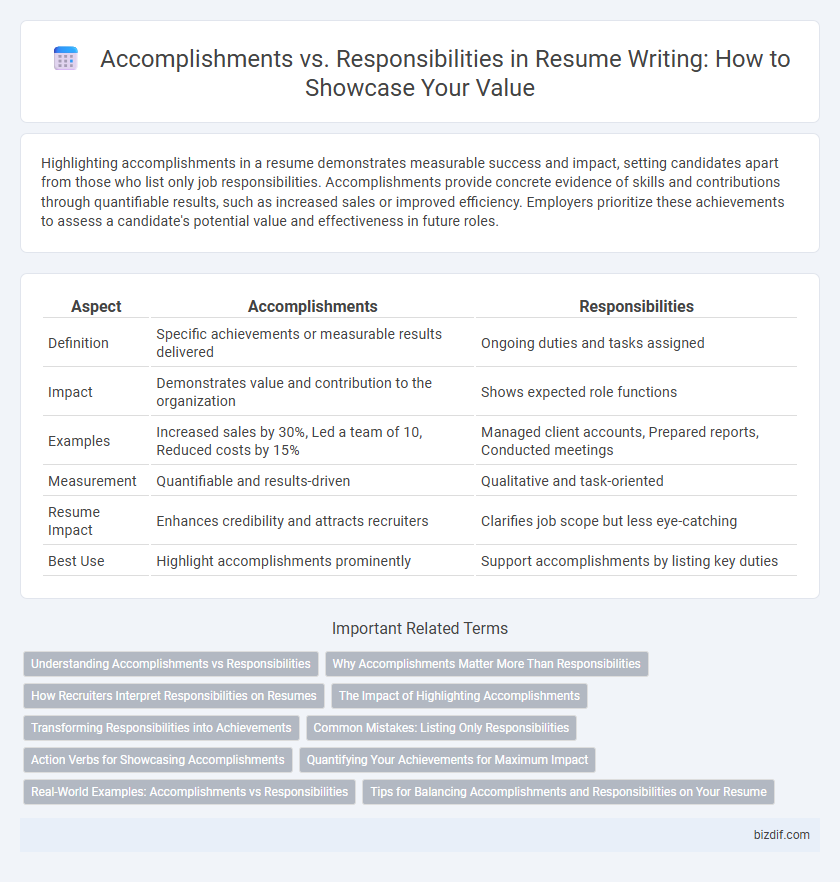Highlighting accomplishments in a resume demonstrates measurable success and impact, setting candidates apart from those who list only job responsibilities. Accomplishments provide concrete evidence of skills and contributions through quantifiable results, such as increased sales or improved efficiency. Employers prioritize these achievements to assess a candidate's potential value and effectiveness in future roles.
Table of Comparison
| Aspect | Accomplishments | Responsibilities |
|---|---|---|
| Definition | Specific achievements or measurable results delivered | Ongoing duties and tasks assigned |
| Impact | Demonstrates value and contribution to the organization | Shows expected role functions |
| Examples | Increased sales by 30%, Led a team of 10, Reduced costs by 15% | Managed client accounts, Prepared reports, Conducted meetings |
| Measurement | Quantifiable and results-driven | Qualitative and task-oriented |
| Resume Impact | Enhances credibility and attracts recruiters | Clarifies job scope but less eye-catching |
| Best Use | Highlight accomplishments prominently | Support accomplishments by listing key duties |
Understanding Accomplishments vs Responsibilities
Accomplishments demonstrate measurable impacts and specific results achieved in previous roles, highlighting your unique contributions. Responsibilities describe routine duties and tasks typically expected within a job position, offering a general overview of your role. Emphasizing accomplishments over responsibilities on a resume enhances credibility and showcases your value to potential employers.
Why Accomplishments Matter More Than Responsibilities
Highlighting accomplishments in a resume demonstrates measurable impact and tangible results that differentiate candidates from others who only list job duties. Accomplishments showcase skills in action and provide concrete evidence of value added to previous employers, making them more persuasive to hiring managers. Focusing on achievements effectively communicates one's unique contributions and potential for future success.
How Recruiters Interpret Responsibilities on Resumes
Recruiters often view responsibilities on resumes as basic job functions that candidates were expected to perform, rather than indicators of exceptional performance. These descriptions provide context but typically do not distinguish applicants or demonstrate their impact within the role. Highlighting accomplishments instead allows candidates to showcase measurable results and unique contributions, which are more compelling for recruiters assessing potential value.
The Impact of Highlighting Accomplishments
Highlighting accomplishments on a resume demonstrates measurable successes and quantifiable outcomes, making candidates stand out to employers by showcasing their real-world impact. Unlike responsibilities, which describe job duties, accomplishments provide concrete evidence of skills in action, such as increased sales by 20% or improved customer satisfaction ratings by 15%. Emphasizing achievements enhances credibility and persuades hiring managers that the candidate will bring tangible value to their organization.
Transforming Responsibilities into Achievements
Transforming responsibilities into achievements on a resume highlights measurable impact rather than mere job duties, showcasing your value to potential employers. Quantify results by including specific metrics, such as increasing sales by 20% or reducing customer complaints by 30%, to demonstrate the effectiveness of your actions. Framing experiences this way positions you as a proactive contributor who drives tangible improvements in the workplace.
Common Mistakes: Listing Only Responsibilities
A common mistake in resume writing is listing only responsibilities instead of accomplishments, which fails to demonstrate the candidate's impact and value to previous employers. Employers seek measurable achievements, such as "increased sales by 20%" or "led a team to complete projects ahead of schedule," rather than generic duties. Highlighting specific results differentiates applicants and showcases their contributions effectively.
Action Verbs for Showcasing Accomplishments
Using strong action verbs like "led," "implemented," and "achieved" effectively highlights accomplishments and demonstrates measurable impact on a resume. Focusing on results-driven verbs helps differentiate contributions from routine responsibilities by emphasizing success and initiative. Incorporating quantifiable outcomes alongside action verbs enhances credibility and captures employers' attention.
Quantifying Your Achievements for Maximum Impact
Quantifying your accomplishments in a resume enhances credibility by showcasing measurable results, such as increased sales by 30% or reduced processing time by 15%. Emphasizing achievements over responsibilities highlights your direct contributions and the value you added to previous roles. Using specific metrics and data-driven outcomes creates a compelling narrative that captures recruiters' attention and sets you apart from other candidates.
Real-World Examples: Accomplishments vs Responsibilities
Highlighting accomplishments on a resume provides measurable evidence of success, such as increasing sales by 20% or leading a project that saved $50,000 in costs, which clearly demonstrates value to potential employers. Responsibilities describe routine duties, like managing a team or overseeing daily operations, but accomplishments showcase how those duties resulted in tangible improvements or exceeded expectations. Employers prioritize real-world examples of achievements because they indicate proactive problem-solving and effective performance beyond basic job functions.
Tips for Balancing Accomplishments and Responsibilities on Your Resume
Highlighting accomplishments over responsibilities showcases measurable impacts and results, which employers prioritize when evaluating candidates. Use quantifiable data, such as percentages or project outcomes, to demonstrate your contributions while briefly listing relevant responsibilities to provide context. Strike a balance by emphasizing achievements that align with job requirements, ensuring your resume effectively communicates both your skills and tangible successes.
Accomplishments vs Responsibilities Infographic

 bizdif.com
bizdif.com